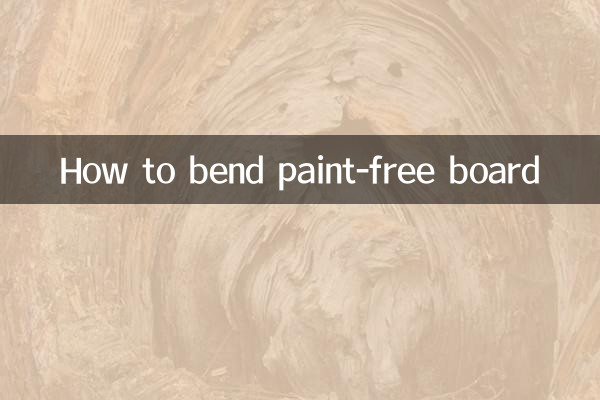How to bend paint-free board
In recent years, paint-free boards have become a popular material for home decoration and furniture production due to their environmental protection, beautiful appearance, and easy installation. However, many users encounter bending difficulties when processing paint-free boards. This article will combine the hot topics and hot content on the Internet in the past 10 days, introduce the bending method of paint-free boards in detail, and provide structured data for reference.
1. Common methods of bending paint-free boards

According to recent discussions among netizens and suggestions from industry experts, the main bending methods for paint-free boards include the following:
| method | Applicable scenarios | Operation steps |
|---|---|---|
| Hot bending method | Small arc bend | 1. Use a hot air gun to evenly heat the surface of the paint-free board; 2. Slowly bend it to the desired arc while it is hot; 3. Cool and shape. |
| Grooving method | large arc bend | 1. Open multiple parallel grooves on the back of the paint-free board; 2. Fill with glue and then bend; 3. Fix until the glue dries. |
| Lamination | Complex shape | 1. Cut the paint-free boards in layers; 2. Bend and paste them layer by layer; 3. Pressurize and cure. |
2. Answers to recent hot questions
According to Internet search data in the past 10 days, the following issues have attracted the most attention:
| Ranking | question | solution |
|---|---|---|
| 1 | Will paint-free boards crack when bent? | Controlling bending speed and temperature reduces the risk of cracking, and the use of specialized bending glue is recommended. |
| 2 | Which type of paint-free board is easiest to bend? | PVC veneer paint-free board has the best flexibility, followed by acrylic veneer board. |
| 3 | How to maintain the curvature after bending? | Use a shaping mold to fix it for more than 24 hours, or use UV glue to quickly cure. |
3. Operation precautions
According to the recent experience shared by decoration experts, special attention should be paid when bending paint-free boards:
1.temperature control: The temperature should be controlled between 120-150℃ during hot bending. Too high temperature will cause surface blistering.
2.Even strength: The force should be applied slowly and evenly to avoid local stress concentration causing fracture.
3.Tool selection: It is recommended to use professional bending fixtures. The top three best-selling bending tools on an e-commerce platform recently are as follows:
| Product name | price range | User ratings |
|---|---|---|
| Multifunctional sheet bender | 200-300 yuan | 4.8/5 |
| Electric hot air bending set | 500-800 yuan | 4.6/5 |
| Portable Grooving Tool | 100-150 yuan | 4.5/5 |
4. Latest technological development
Two new technologies that appeared at recent industry exhibitions are worthy of attention:
1.Flexible paint-free board: A new paint-free board launched by a certain brand can achieve 90-degree bending without cracking and is expected to be launched by the end of 2023.
2.Intelligent bending equipment: Use AI algorithm to automatically calculate optimal bending parameters to reduce trial and error costs.
5. Sharing of practical cases
Bending process data recently released by a well-known furniture brand:
| product type | bending radius | Qualification rate | working hours |
|---|---|---|---|
| curved wardrobe | 500mm | 92% | 3h/item |
| wavy partition | 300mm | 85% | 5h/item |
| Round countertop | 800mm | 95% | 4h/item |
It can be seen from the above methods and data that the bending processing of paint-free boards requires a combination of material properties, tool selection and technical essentials. It is recommended that first-time tryers start with simple hot bending methods and gradually master more complex processing techniques. With the development of new technologies, the application scope of paint-free boards will be further expanded.

check the details

check the details